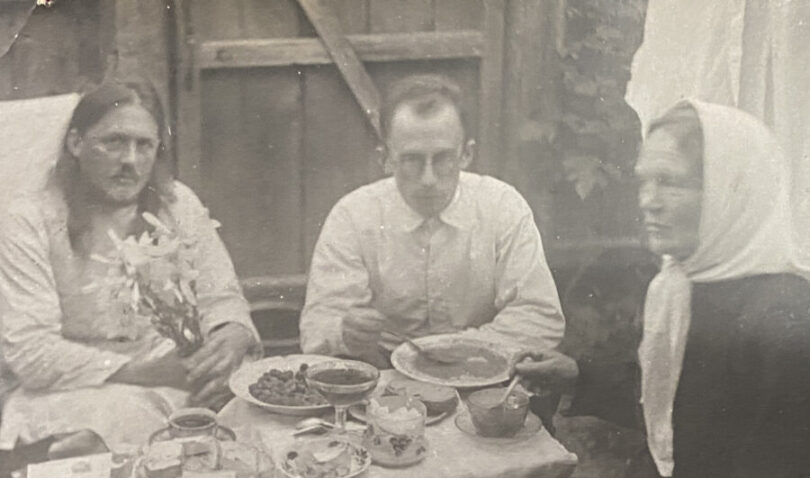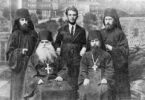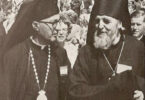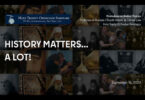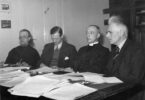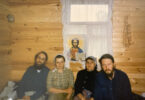From the Editor
In 1970, the North American Metropolia of the Russian Orthodox Church received a grant of autocephaly from the Moscow Patriarchate. In reaction to this act, the 1971 Council of Bishops of the Russian Church Abroad adopted a resolution stating that it considered the Catacomb Church, not the Moscow Patriarchate, to be its mother church:
“The free part of the Russian Church, which finds itself outside the boundaries of the USSR, is heart and soul with the confessors of the faith, whom the anti-religious manuals call “True Orthodox Christians,” and who in common usage are often called “the Catacomb Church;” for they are obliged to hide themselves from the civil authorities in the same way that believers hid in the catacombs in the first centuries of Christianity.” [1] The English translation is cited from “The True Orthodox Church and the Russian Church Abroad,” Russia’s Catacomb Saints (Platina, CA: St. Herman of Alaska Press, 1982), 573.
In 1974, Alexander Solzhenitsyn was exiled from the USSR. In his interview, Aleksei Beglov references Solzhenitsyn’s letter to the Third All-Diaspora Council in Holy Trinity Monastery, Jordanville, from September 7–22, 1974, which called for understanding of the variegated reality of church life in the USSR. The letter was written in response to a request by Metropolitan Philaret to elaborate on “how the unoppressed part of the Russian Orthodox Church might help its oppressed, captive part” (Letter to A. I. Solzhenitsyn). Aleksei Beglov draws our attention to those Orthodox Christians about whom Solzhenitsyn writes, who were underground yet in communion with the Moscow Patriarchate:
“The supplanting of the real Russian nation with an image of a catacomb church is not what we need today. We must not do as I have noticed in some of your publications: we must neither ignore, nor avoid through closed-mindedness the resurgent and strengthening Orthodoxy in our country. Our task today is much more complicated, more complex, but also more joyous than mere solidarity with some secret, sinless – but also bodiless – catacomb church.” [2]Alexander Solzhenitsyn, “Letter To the Third Council of the Russian Orthodox Church Abroad,” August 1974, Historical Studies of the Russian Church Abroad, … Continue reading
Unlike Aleksei Beglov, I myself am more familiar with catacomb Christians who were not in communion with the Moscow Patriarchate. In 1990, I came to Holy Trinity Seminary with a blessing from Bishop Lazar′ Zhurbenko of Tambov and Morshansk, who had been consecrated by the ROCOR in 1982 for underground ministry in the USSR. On the basis of information supplied by Bishop Lazar′, the ROCOR Synod of Bishops issued a statement denying the apostolic succession of the bishops of the Catacomb Church in Russia at that time. Inasmuch as the ROCOR had declared the Catacomb Church to be her mother church in 1971, it was strange that its relations with the Catacomb Church had reached such an impasse. In summer 1996, I undertook an expedition to Russia and Belarus′ to meet the hierarchs of the Serafim-Gennadii Branch of the Catacomb Church. I was puzzled by the fact that they had no interest whatsoever in dialogue with the ROCOR. It would seem that Christians ought to do everything within their power to maintain communion with like-minded brethren. The report on the results of the trip submitted to Archbishop Laurus, Secretary of the Synod of Bishops, was passed on to the Archive of the Synod of Bishops in New York. Unexpectedly, it played a role by serving as a justification for receiving two bishops of the Serafim-Gennadii Branch into the jurisdiction of Bishop Agafangel (Pashkovskii) in 2008. In the underground church in Russia, alongside those who did not accept Metropolitan Sergius’ (Stargorodskii) church policy and those who remained in communion with the Moscow Patriarchate, there existed a movement of episcopi vagantes. The Serafim-Gennadii Branch, which did not have any ecclesiological differences with the Moscow Patriarchate or confirmation of its apostolic succession, belongs in this category. One of the results of the end of the period of the persecution of the Russian Church was the fact that the part of the Russian Church that had escaped persecution abroad was reunited with the captive Russian Church in the homeland, while members of the underground church joined forces with those who rejected the reunification of the church in the homeland and the diaspora.
Deacon Andrei Psarev, March 24, 2021
Aleksei L′vovich, your book In Search of the ‘Sinless Catacombs’ was published in 2008. Anyone not familiar with the subject would be quite mystified by this title.
This book was written a long time ago. The text that formed the basis for it was written sometime in 2004–2005. Four years later, it was published by a small publishing house called Arefa. It was then that it became widely known. In 2018, a second, expanded edition was published by the ROSSPEN (ROSsiiskaia Politicheskaia ENtsiklopediia, The Political Encyclopedia of Russia) publishing house, as part of their History of Stalinism series. Where did the title come from? In the title, the phrase ‘sinless catacombs’ is in quotation marks for a reason. It is a quote from a letter of Alexander Solzhenitsyn, addressed to none other than a council of the Russian Orthodox Church Outside of Russia (the Third All-Diaspora Council, held at Holy Trinity Monastery, Jordanville, in 1974 –ed.), in which Solzhenitsyn, recently exiled from the Soviet Union, addressed the Council and pointed out that the focus of the hierarchy of the Church Abroad on a “sinless – but also bodiless – catacomb church” (his words) was unreasonable, and effectively left no room to connect with the true people of the Church in Russia, who, as Solzhenitsyn wrote, had preserved their link to the mother church: that of the Moscow Patriarchate. This quote is thus taken up in the title: Solzhenitsyn’s ‘sinless catacombs’, ever so slightly paraphrased. Yet the book also has a subtitle, “The Underground Church in the USSR in the 1920s–40s”. In the book, there is an epilogue, if it can be called that: a rather large chapter in which I give an overview of the evolution of this phenomenon after the ’40s, from the 1950s–80s. Perhaps, for the benefit of those who haven’t seen the book, I should tell you how it is structured and what parts it comprises. Chronologically, the study is divided into two parts. The first part describes the situation from 1917 through the late 1930s, and the second part is about the ’40s and early ’50s, from the late ’30s to the early ’50s. In each of these parts, there are four chapters or four sections. The first describes state policy toward the church and illegal church entities. I show that, in many ways, the Soviet authorities created the requisite conditions for the formation of these illegal church bodies. The second section of each chapter is a description of processes in the underground church, its makeup, and the development of elements of church life deemed illegal by the authorities. There is a section in each chapter on the problem of the interaction between the underground and the legitimate episcopate of the Russian Orthodox Church. The fourth section of both parts is written from the perspective of historical anthropology. I try to look at the mentality of the people in the underground church, at their survival strategies, and at church praxis under these conditions. The fourth section of both parts is about this. Perhaps I should clarify why I am speaking specifically about the underground church, whereas in the consciousness of the church and society, the word ‘catacomb’ is probably more frequent and more familiar. I will go on a small digression here. In the mid-1990s, as a young man, I had the good fortune to communicate with some of the secret monastic communities of the prewar period. These were some of the secret nuns who had survived into the 1990s, a new era in the life of the church and the country, and I, among others, had the good fortune to communicate with them. At some point I was, in a sense, given that honor. I began to publish some of the materials preserved by these nuns: memoirs and writings left by their spiritual fathers, who did not survive the 1930s and were executed or died in prison. This material formed the basis for my doctoral (candidate of sciences) dissertation. I tried to frame it in an academic way or format, and I spent some time working in the archives to have a look at the context in which these communities existed, because my original task – to describe them in a monographical way – was rather narrow. The communities in question are called the Moscow Vysokopetrovskii Monastery communities. In the late 1920s, a number of communities were formed around several clerics of the monastery. Nun Ignatia (Puzik, Petrovskaia, d. 2004) was one of the main drivers of this process and, in fact, many – though not all – of the published materials stemmed from her pen and her personal archive. Working in the archives, I discovered that this was not a unique situation. The Petrovskii Monastery communities were not the only ones, and a rather rich, varied, very dramatic, intense, and hidden Russian church life, first in the prewar years and then in the 1940s, gradually began to reveal itself to me. I realized that it was necessary to write not only about the Petrovskii communities but to state the question or problem more broadly. Thus began the history of the study we are talking about today. When I started working on it, I realized that using the word ‘catacombs’ to refer to this phenomenon is not very correct from an academic point of view, because at that time, in the ’90s, and partly also now, there were two interpretations or perceptions of this phenomenon or concept of the ‘catacombs’. One interpretation, which was also largely supported by authors in the diaspora, was that the concept of catacombs was the sum of several meanings. First, underground, illegal church life. Second, opposition to the Russian Church of the Moscow Patriarchate. And the third point is an anti-Soviet attitude toward reality and the Soviet regime. In the Soviet Union, the term ‘catacombs’ did occur, albeit less frequently than in the writings of diaspora authors.
Genuine Orthodox Christians (GOC). This is the term Soviet historians used. Subsequently, it found its way into the diaspora and this choice of words largely corroborated the preconceptions of those in the diaspora.
Yes. In fact, when I began studying this issue, it was evident that in church circles, this word was in use in Russia and in the Soviet Union, too, but with a slightly different meaning than it had in the diaspora, specifically, with the meaning of the hidden life of the church, of catacombs in this sense. For example, in the autobiographical notes of Archpriest Gleb Kaleda, who himself was a secret priest for 18 years, the word ‘catacomb’ is used, but context shows that it refers simply to underground church life. I tried to distance myself from this notion for a very simple reason: it seemed to me to be too journalistic and not academic enough, and I found it important to distinguish among the concepts that had been conflated into the notion of the ‘catacombs’. That is, I began to speak separately about church life that was illegal from the point of view of the Soviet authorities and was legally banned. By the way, Soviet public figures themselves also used the expression ‘underground’ or ‘illegal church life’. One of the first such public references was in a 1929 brochure on the Feodorovtsy (the followers of Archbishop Feodor Pozdeevskii –ed.). There, too, we find a reference to the ‘underground’. This is the first point. I defined ‘underground’ in strictly legal terms. Legal and illegal. At the same time, I found it important to give separate consideration to the problem of opposition groups and that of pro-Soviet and anti-Soviet attitudes, because when I began to study this issue, it became clear that outside of the realm of legality, the groups that had been forced underground could have a great variety of attitudes. There were those that were truly in opposition, initially to Metropolitan Sergius (Stragorodskii) and later to Patriarch Alexis I (Simanskii). There were groups that were absolutely loyalist, in particular the Petrovskii monastic communities. They are one example of loyalist underground clergy in the Russian Church. There is a section in which I discuss their survival strategies. One of these was a kind of isolationist strategy based on very strong anti-Soviet rhetoric and an anti-Soviet eschatology, which characterized a significant number of church communities, including underground communities in the prewar era and the 1940s. Simultaneously, we see communities whose members worked Soviet jobs, that is, lived ordinary lives with an emphasis on keeping the faith alive. If they were monastics, they tried to maintain an inner monastic life and were focused primarily on this. Those communities which emphasized maintaining an inner spiritual life could be oppositional or part of the ecclesiastical opposition, but not anti-Soviet. There were all manner of permutations in the church underground, and I specifically wanted to describe and record all the richness of these variations in church life. To my great surprise, it turned out that even state sources in general contain many mentions of this, albeit not on the surface. Though, of course, I tried to rely not only on these sources, but also on what the members of the illegal church communities had produced themselves.
From the protocols of the interrogation of Serafim Pozdeev, published by the historian Petrov, one gets the impression he was merely struggling to survive in the turbulent, transformative conditions of the 1920s. That he was caught in the current. People came to believe that he was Mikhail, the Grand Duke. ‘Well, then, so be it.’ He was a survivor. The underground was precisely that: the underground. One finds all sorts of things swept under the rug.
Yes, what you are talking about, this kind of religious and political imposture, was very typical of the prewar period. There are now publications and even some monographs on this subject. We can see how widespread this was, with some people being recognized as members of the imperial house that had miraculously escaped or as other persons. Here we must understand that this kind of religious and political imposture, sometimes unwitting, was to a large extent accommodated by powerful psychological expectations. The Chuvash historian German has published on the case of one of the women who was accepted and passed off as being the miraculously rescued Grand Duchess Anastasia. One of her admirers states outright that, since she had been saved and appeared in our midst, then the Soviet regime would soon end. They thus began hiding her in this expectation. The end of the Soviet regime was certainly associated with a kind of religious deliverance. It was explicitly said somewhere that it was a matter of the Second Coming. In any case, this is what it was associated with, because it is clear that for these groups, the Soviet government was associated with the rule of the Antichrist. There were all sorts of permutations here. Later on it the book, I write about these eschatological groups, but what is even more interesting are the groups that were not so sharply eschatologically oriented, but rather tried to build up a kind of survival strategy in these completely inhumane conditions. Here we encounter monastic communities in the first instance, not only the Petrovskii ones I have already spoken about, but we know now that the earliest secret monastic communities – ones that were secret from the beginning, that is, that did not take shape after the closure of a monastery when the monks simply dispersed and lived in a semi-concealed state, but those that were directly created as secret monastic communities – were founded in Petrograd as early as 1922 during the campaign to seize church valuables. Apparently, Hieromartyr Saint Benjamin (Kazanskii) was aware of and somehow sanctioned this activity (though we cannot speak here of a blessing). In the 1920s and ’30s, there were three communities there: two in the city, and one in old Peterhof. They were partially broken up in the early ’30s, but some of their members survived. The future Metropolitan Gurii (Egorov) took them to Central Asia, where they lived on until 1944. This is also a very interesting point. Many of them later went into public ministry. That is, they also belonged to the loyalist, non-oppositional part of the underground church. There are very interesting documents and reminiscences about how they structured their spiritual life and how they were able to keep the secret of their struggle and their ministry, since they had quite an intense spiritual life. In Central Asia in particular, they had a little house where they had daily services very early before going to work. They served the Liturgy. The Petrovskii communities were a fairly large cluster of monastic communities. The total number of secret monastics in them, according to my calculations, was about 170–200. There were several father-confessors. They were not all under the care of one father-confessor, of course, but it was the largest clandestine monastic community that we are aware of in this period. Understandably, a great many of them perished. Initially, these communities were mixed, with both men and women, but by the 1940s, there were almost no men left. One after another, they began to serve openly, were exiled, went to the camps, and almost all died. One man survived the 1940s, one monk and confessor, Father Isidor (Skachkov), who provided pastoral care for them after the war. They were almost all women by then. All the same, it was a very interesting, powerful group aimed at maintaining a spiritual life in the Orthodox ascetic tradition.
Aleksei L′vovich, I was just about to ask you about one thing. You mentioned that none of them survived the 1930s. After the war, it turns out that there were some who were closer to the Church Abroad and not in communion with Metropolitan Sergius – Holy Confessor Vasilii of Kineshma, Archbishop Peter Ladygin, and Antonii (Golynskii-Mikhailovskii: what is the current view about his ordination? Has it been confirmed or not?) – but in fact I can think of only two bishops who were not in communion with the official church. And then a number of these fathers, such as Hieroconfessor Afanasii (Sakharov), made calls to return to and to recognize the Moscow Patriarchate as represented by Alexis I, who was recognized by the Eastern Patriarchs. It turns out that after World War II, there were effectively no bishops left in the USSR who were not in communion with the Moscow Patriarchate at some point.
This is a difficult question because ordination histories can be extremely muddled. Overall, it is more likely than not that this was the case. There are some very interesting nuances to keep in mind here. For example, if we take Schema-bishop Peter, then, if we interpret the reminiscences of his unfortunately now-deceased disciple Schema-archimandrite Serafim (Tomin) correctly, it was Serafim, his disciple, who was in communion with the Moscow Patriarchate. At one point, he was even sent to Mount Athos and was part of the delegation or group of monastics that was sent to Saint Panteleimon Monastery in the 1960s to support the spiritual life there and which later returned to Russia – even though he began his monastic life in entirely secret conditions, in secret monasteries and hermitages in the southern Urals and in Central Asia, without being directly in communion [with the Moscow Patriarchate]. Here we have a lot of very different individual stories, and the matter of the hierarchy was really quite complicated. Quite a lot of documents have now been published, studies, for example, about the community of the Sisters of Diveevo in Murom. They had a very interesting stance. It was quite a large group. As far as we know, there were several dozen people in it. They did not all live together, but they constituted a community, communicated constantly, and had the same father-confessors. In the prewar period, they adopted quite a consistent oppositional position, but at some point in the 1940s, they gradually began to turn to clergy of the Moscow Patriarchate while remaining a secret community. There was a very interesting conflict between the Murom branch of the Diveevo communities and those sisters who had remained in Diveevo. In Diveevo itself, there was also a smaller group that continued to live around the monastery. Of course, everything there was in disrepair, but they stayed there all the same. They met to discuss whether to petition for the opening of the Church of Our Lady of Kazan in Diveevo as a parish church around which the community could unite. The Diveevo sisters took the more radical position that they would not ask for it to be opened and they would stay in their catacombs. The Murom sisters were saying that it was already possible to come together and have open services there, which would allow them to be close to the holy place and community of Diveevo. But this did not happen, and they remained in Murom, as did a portion of their holy objects. You have to understand that these ecclesiopolitical stances, that is, church politics, were dynamic and susceptible to change. They could change over time, depending on which clergyman or bishop they were communicating with at any given moment. Very often, a pastor was chosen not because of his particular ecclesiopolitical stance, but simply by virtue of his spiritual merits or qualities, or his ascetic experience, if we are talking about monastics.
By virtue of trust?
Yes, of course. Among other things. This is a point of first-order importance. It is very interesting that we speak now mostly about monastics, though we must realize that there were a considerable number of lay communities or, to use the term loosely, of underground parishes. While monastics began to appear as early as the early 1920s, the parishes emerged during the era of collectivization. After collectivization, a considerable number of these parish communities found themselves without churches and priests, and sometimes with priests but without churches. In some places, they continued their life in their homes; elsewhere they celebrated lay services; in other places still, they sought out clergy or were joined by nuns who knew the services and kept up the liturgical tradition. They were sometimes very large associations. The Soviet government very often recorded that, according a village council in some village or other, several hundred parishioners of a secret church had assembled for a feast. Interestingly, in the 1940s, they very often asked for churches to be opened. Not all of them succeeded. Some still remained outside the realm of legality, but others got their way. Why am I talking about this? We know of several cases where opposition groups sought to have themselves legalized in the ’40s. For example, in Viatka, those who considered themselves to be the followers of Bishop Viktor (Ostrovidov, d. 1934, glorified as a saint in the ROCOR and the Russian Orthodox Church –ed.), a convicted and very radical member of the opposition, tried to get themselves legalized without entering into communion with the Moscow Patriarchate. On the whole, they did not succeed, but there were such attempts, and regular ones at that. One of the most persistent communities that had long been trying to get legalized was sent an archimandrite who had previously been imprisoned, and they agreed to accept him. They thus obtained legal status. They were, in a way, formally reunited with the Moscow Patriarchate, even though it was it is clear that everything hinged on this one figure. The bishop acted wisely in sending them such a pastor, a confessor of the faith whose spiritual stature was not subject to any doubt, which meant that they accepted him. We know that the last of the so-called Josephite churches existed in the Leningrad Region right up to the post-war era. But by then, there were big problems with the hierarchy and substantial doubts about their status. In spite of this, there were still oppositional clergy. Everything depended on the region. But the matter of the episcopate was very complicated.
Yes, in fact, one of the Rozhdestvenskii brothers, Fathers Izmail and Mikhail – one of them, I think Mikhail Rozhdestvenskii, lived until 1985. It so happens that he entered into communion with Bishop Lazar′ of the Russian Church Abroad. How can we quantify the communities that were not in communion with the Moscow Patriarchate after the war? What movements were there and and how can we estimate their size?
I have tried to address this question statistically. The first thing that must be said here concerns sources. What materials do we have on this subject? It is clear that we very often know nothing about the communities that did not declare themselves in any way. But in the late ’40s, in 1948, the Council on the Russian Orthodox Church, under its first chairman, Karpov, tried to conduct a statistical study of illegal forms of church life. They did not get information from all the regions. They just didn’t have time for this, because the situation had changed and this information was no longer being collected. But we do have information from several regions. There are several tables in the appendix of the book, particularly from Riazan′ and Nizhnii Novgorod Regions. There are also relevant materials there. Why, by the way, was Karpov doing this? It was not always in order to pave the way for repressive action. One must understand that, while in the prewar years (the 1920s–30s), any underground phenomenon could serve as an occasion for severe repression, by the 1940s, the situation had changed and we see many times in documents of the Council for the Affairs of Russian Orthodox Church Affairs that ordinary members of such communities were subjected to preventive measures, that is, conversations or some kind of administrative action, whereas only the leaders were subject to repressions. It was necessary to identify the leaders and make specifically targeted arrests. This is a rather interesting point. In addition, the Council on the Affairs of the Russian Orthodox Church very often made reference to the fact that there were underground communities somewhere in some region in dialogue with the party authorities as an argument in favor of opening a church there – strange as that may seem. That is, it adopted a rather intermediate stance among Party agencies that were more anti-Church. The Council’s pragmatic strategy was that, if people were already congregating somewhere, one church ought to be opened for several districts and this would be better than if the people were to continue to congregate where they had been before. They imagined that there were hundreds of communities in certain areas in the 1940s. These were, loosely speaking, underground parishes. How can we define their church-political stance? Oppositional or loyalist? The clearest criteria are attempts at legalization. Did they undertake such attempts or not? I already gave the example of the ‘Viktorites’ in Viatka, who, despite being part of the opposition, still tried to get themselves legalized. Most understood legalization as meaning unity with the Russian Church of the Moscow Patriarchate, but after the liquidation of Renovationism (in 1946 –ed.), there were no alternatives. Especially if they did not have their own clergy. And what do we see here? We see that, while there may have been different proportions in individual regions, on the whole, two-thirds of all communities sought to be legalized. Two-thirds! That doesn’t mean that the remaining third was strictly oppositional. There may have been different situations. They might not have had time or not obtained the right number of signatories for their petition. Or if their leaders were nuns, as the relevant tables in the study show, they very often resisted registration. The community wanted to, but the nun resisted, because it was clear that a priest would come and she would lose her status as the undisputed leader of the community. That is, this remaining third was not solidly oppositional. There were those who hesitated for some reason. You have to understand that after 1948, there were no more legalizations until 1954. For six years. After the autumn of 1948, Stalin effectively imposed a veto on legalization. Why that was, is a separate question. The final lists approving the opening of communities were always signed by one of his deputies, usually Voroshilov. Stalin made a scene at a meeting of the Council of Ministers because the lists had been drawn up without him, even though this had been a common practice since 1945, when he himself almost never signed the lists for the opening of churches. Yet here he made a scene in order to have it all canceled immediately. Several dozen churches that had already been given official permission saw this right revoked because they were on that very last list. After that, no petitions whatsoever were signed until after Stalin’s death. That is, for six years, there was a complete hiatus in legalization. Many communities simply didn’t make it in time. Because there was a war, they were looking forward to 1945, or, loosely speaking, to 1944. In fact, from 1945 to 1948, there were three years of opening churches, of real legalization. Many congregations, especially in the hinterland, did not have time to get oriented amid all of this. But according to the data we have, two-thirds sought to be legalized. At least we can say that they were loyalists – loyalist illegal congregations forced underground by repression and by the closure of churches during the era of collectivization. These were congregations that had continued to lead some kind of lay life, or which had clergy or nuns and tried to have themselves legalized. Some succeeded, and some did not. It is clear that in the territories occupied during the war, where the process of legalization was very rapid – rapid and spontaneous, because the Germans tried to use it in propaganda – it was a grassroots movement. There was more legalization there. After the war, all of them joined the Moscow Patriarchate in one way or another, and in non-occupied territories, it was the two-thirds we were talking about. As it happens, we have specific statistics about clergy in individual regions. Not just about congregations, but about clergy who sought to have themselves legalized. We have to understand that the legalization of previously non-serving clergy provided most of the personnel for the Moscow Patriarchate in the 1940s. The seminaries could not cope. They were few and far between. And when clergy who had been living in the underground or in prison returned to ministry, they did so in the dozens. It was these people – broadly speaking, underground priests – who came out and began to serve openly again. Not all of them were really ‘underground’. Some of them had just gone into hiding and led quiet lives without conducting services, although more often than not, they has been conducting services, even if only for a very small circle of people.
Aleksei L′vovich, there is still that one third, and there are questions about it as well. Is it possible to convert it into some quantifiable units or numbers?
No, but we can look at individual regions. Let me open up a table for Nizhnii Novgorod Region. Riazan′ Region has come up. Here, I have Tambov and Nizhnii Novgorod Regions. Communities that never submitted an petition to open churches. How many of them are there? In Gor′kii Region, it is almost 50/50, with 28 unregistered congregations that submitted one and 27 that did not. Take Riazan′ Region. There are more than 100 communities that submitted a petition and about 80 that did not. There is a table that is structured according to who was their leader was. There is a very clear correlation: if it was a priest, the community usually tried to legalize. If it was a monastic, especially a lay nun, it was more difficult. In other regions, we come to the figure that I was talking about.
But it is also difficult to speak about the affiliations of those who did not submit a petition. What was their stance? In favor of the Moscow Patriarchate?
This is very difficult. We have practically no information on them, because the Soviet researchers who later worked as ethnographers and conducted field research of this sort began to do so much later, in the late 1950s and 1960s. That is a very big gap in time – almost a decade. By then, there were Christians of a very different kind. They were getting older. There was a generational gap. We can only look at specific regions. There are, for example, statistics for Voronezh Region. In Voronezh Region, there were those who were called the ‘Buiites’. Bishop Aleksei of Urazov (Bui, d. 1937) was an outstanding bright opposition leader who had already died by this time. Possibly also in the Viatka Region. There were people there claiming to be ‘Viktorites’. Most, of course, were silent, the silent majority.
Aleksei L′vovich, I would like to thank you for your work. In 1999, Mikhail Vitalievich Shkarovskii published a monograph, The Josephites [Iosifliane], with an appendix with information about people. I began to work with him to turn it into a special catalog. I myself stepped back from this project, but my late comrade Dmitrii Pavlovich Anashkin completed it together with him. It was published in 2013 by ROSSPEN, who also published your book Pravoslavnoe tserkovnoe soprotivlenie v SSSR [Orthodox Ecclesiastical Resistance in the USSR]. Looking at this catalog of people, I thought no one would ever use it and no one needed it, but I am glad to see that it seems my pessimism has been proven wrong.
Of course, all the more so now. The book was published a relatively long time ago. The second edition only corrected a few mistakes, mostly typos. Now, after the archives have been opened up, especially in the Ukraine, there are a lot of researchers working in this field. We should not expect any highly new data, but gradually, the picture will be filled out. I closely follow the research of Ukrainian colleagues in this field and I am satisfied to see that some of my conceptions do not have to be seriously revised. We are simply seeing new material that generally fits into the scheme of the rather complex and rich underground church life I wrote about in the study. Church life during the Soviet period was a kind of iceberg submerged below the waterline, which is where illegal church life was. At some points, it resurfaced, as in the 1940s, but overall there was certainly more of it below water than above. Yet we must understand that the whole sum of church life that remained outside the bounds of legality was by no means always oppositional. Quite the opposite. Above all, personal ties with the Russian Orthodox Church under the Moscow Patriarchate were preserved and in a sense, it was a single space, a single body, divided by Soviet legislation.
Thank you very much, Aleksei L′vovich, for taking the time to talk about your important work; I wish you every success in researching this topic.
Conducted by Deacon Andrei Psarev
References
| ↵1 | The English translation is cited from “The True Orthodox Church and the Russian Church Abroad,” Russia’s Catacomb Saints (Platina, CA: St. Herman of Alaska Press, 1982), 573. |
|---|---|
| ↵2 | Alexander Solzhenitsyn, “Letter To the Third Council of the Russian Orthodox Church Abroad,” August 1974, Historical Studies of the Russian Church Abroad, https://www.rocorstudies.org/2012/12/12/letter-to-the-third-council-of-the-russian-orthodox-church-abroad/ (March 24, 2021) |

